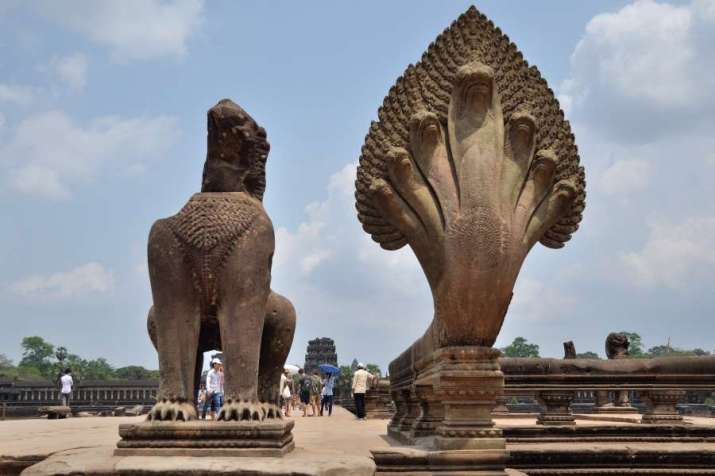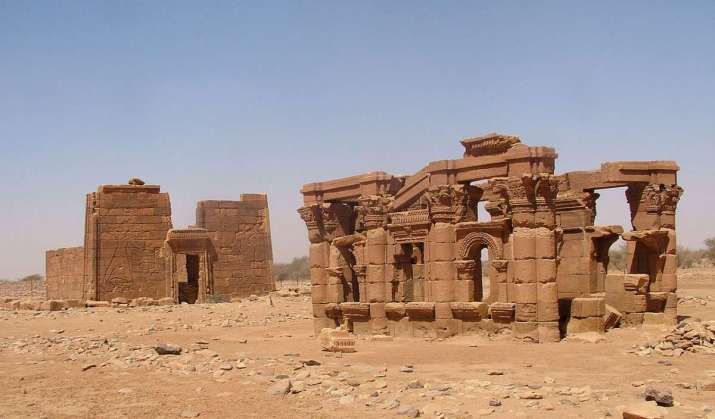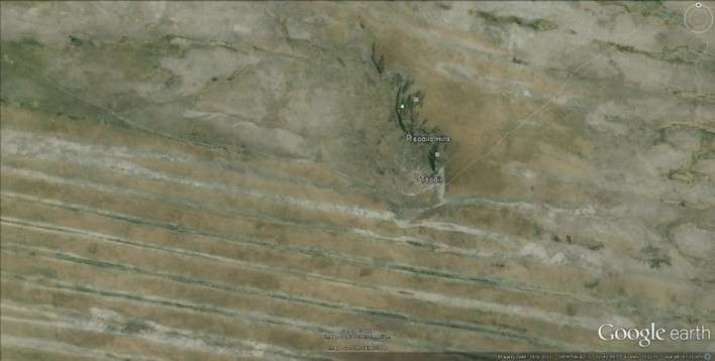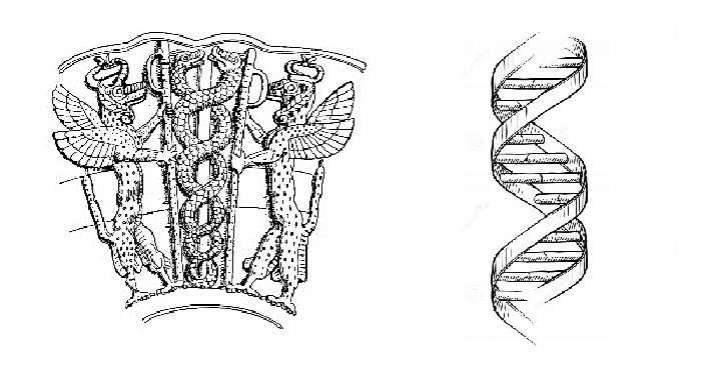FEATURES|COLUMNS|Silk Alchemy
The Iconography of Nagas, Part Three: DNA in History
 Members of the Angami tribe, one of the Naga tribes of Nagaland, in ceremonial dress for the Sekrenyi Festival. From responsiblevacation.com
Members of the Angami tribe, one of the Naga tribes of Nagaland, in ceremonial dress for the Sekrenyi Festival. From responsiblevacation.comSymbols and mythology are the language we use to transcend cultural barriers as well as time. When we embed information into song, story, or stone, we are more likely to have the information successfully transmitted beyond a mere lifespan. However, over a great expanse of time and social change, these myths and symbols need decoding—with discernment, but without the hubris of dismissing elements incongruent with our subjective proclivities, or with the presumptions of our modern culture and its Newtonian, materialist mindset.
Many years ago, I joined the ranks of curious minds fascinated by messages hidden in plain sight, as well as anomalies to classical timelines. And none of the motifs is so global in humanity’s story than the serpent. In the previous two articles of this series, I looked at some of the folklore, syncretism, and science behind serpentine symbols and ophiolatry (serpent worship). I fully acknowledge that I have not particularly examined the Celtic, Scandinavian, or South American relationship with snakes and dragons as it is an enormous subject to document in a lifetime, let alone in a series of short essays. That said, the exploration of synthesizing potential root meanings takes one to unexpected places. In this article, I will look at history, starting with the arguable personification of the serpent (where “naga” is used to describe a tribe of people) if in name and myth only.
The term naga is used to denote groups of people in various myths and folk tales across Asia. They are mentioned in the Rigveda, in which a tribe named Naga was defeated by Lord Krishna and then migrated to Sri Lanka. Another folk tale narrates that Brahma sent the Naga to live under the sea, while in the Hindu epic the Mahabharata, the Naga were a divine race of beings that existed on Earth long before us humans. In Cambodian legends, the Naga were a nobel race from a large empire somewhere in the Pacific, and the ancestors of modern Cambodians. In their legends, the serpent is symbolised as a seven-headed creature representing the colors of the rainbow, bringing to mind Australia’s Rainbow Serpent and the Aboriginal creation stories (see the previous article in this series). One thing remains congruent in all the research on naga origins, however: they are usually connected to water.
 Seven-headed naga, right, next to a guardian lion at Angkor Wat, Cambodia. From tour-to-cambodia.com
Seven-headed naga, right, next to a guardian lion at Angkor Wat, Cambodia. From tour-to-cambodia.comIn the present day, there are more 50 tribes around the world with the name Naga. Most of them are noted as Indo-Mongoloid indigenous peoples located in northeast India and central and northern Myanmar. So let’s trace look at the genetic history of these Naga people, just out of curiosity.
According to the discovery of the M130 gene—the oldest traceable DNA found in India so far—the original inhabitants of India were migrating tribes with Afro-Australian blood. They are known to us as the Dravidians.*
Where else can we find the term naga? It turns out that Naga (or Naqa) was also a city in the ancient Kushite (Cushite) Kingdom of Meroë. Simple coincidence? Perhaps. This empire sprawled in what we now refer to as Sudan and South Sudan, and was known as Aethiopia in early Greek geography. Archaeologists have cited Naga as one of the most important centers of this flourishing civilization in sub-Saharan Africa. In the 5th century BCE, Greek historian Herodotus described it as “a great city . . . said to be the mother city of the other Ethiopians.” Meroë was a successful international trading hub for ironwork, pottery, and crafts with civilizations such as China and India. Evidence of the first Ethiopians in India dates back to the 4th century BCE, but their presence flourished between the 14th and 17th centuries.
 The Roman Kiosk and the Temple of Apedemak in Naga (Naqa). From wikipedia.org
The Roman Kiosk and the Temple of Apedemak in Naga (Naqa). From wikipedia.orgIn Wonderful Ethiopians of the Ancient Cushite Empire: Origin of the Civilization from the Cushites (1926), American writer, historian, educator, and journalist Drusilla Dunjee Houston (1876–1941) wrote, “To those who read the Rigveda intelligently and without confusing glasses of prejudice, these mutilated and interpolated writings are but a description of the familiar traits and customs of the Cushite Ethiopians. The Brahmins were probably a much later and intermixed branch of the inhabitants of Hindu-Kush . . . full blooded Cushites are very gentle. . . . The Dravidians in ethnic type are Ethiopian and are the race of India from which her civilization originated. . . .They occupy the oldest geological formation of India.”
Even in Vita Apollonii, Philostratus (c. 170/172 – 247/250) makes a connection between India and Ethiopia: “The Indi are the wisest of mankind. The Ethiopians are a colony of them, and they inherit the wisdom of their fathers.” The ancient Jewish religious manuscripts, The Book of Enoch and The Book of Jubilees, that allegedly contain various wisdoms and information about the time from creation to the time of Moses, were written in Ge'ez, an ancient language of the Ethiopian Semitic group, for example.
The relationship between the kingdom of Kush and that of Kemet, the ancient name for Egypt, is interesting. Even orthodox historians are starting to understand how important and advanced the Kush civilization was, and that they may have had similar if not more advanced esoteric and celestial knowledge that the Egyptians did at a later date. The Nabta Playa** and the UNESCO site Tiya*** are still baffling historians. Even more curious is the enormous irrigation system surrounding the Tsodilo Hills in Botswana. As I mentioned in part two of this series, the San people of the Tsodilo Hills carry some of the most divergent (oldest) Y-chromosome haplogroups. So let’s explore this genetic aspect further.
 Arial image of the Tsodilo Hills with surrounding erosion patterns that seem to be irrigation canals, about a mile apart. From ancientmistery.weebly.com
Arial image of the Tsodilo Hills with surrounding erosion patterns that seem to be irrigation canals, about a mile apart. From ancientmistery.weebly.comBased on studies of mitochondrial DNA, molecular biologists date the origin of our particular hominid species to an African Eve who live some 236,000 years ago. This theory supports the Darwinian idea that all modern humans evolved and migrated from ancestors in East Africa. However, with the inevitable slow stream of new discoveries, classifications of Hominini (a taxonomic tribe of the subfamily Homininae “hominines” that includes the genus Homo, humans, but excludes genus Gorilla, gorilla) and their associated age and geographical location are are now hotly debated.
Regardless, the specific geography of human origin interests me less (if there even is one), and I have no inclination to favor one theory over another. What is interesting, however, is the age and the first alleged divergence of hominoids (divergence of apes, ancestors of modern apes and humans, from monkeys), now dated to around 25 million years ago. When we reflect on the dramatic societal changes of the past 100 years, it’s incredible to witness our progress, yet by the same token we need to consider how extraordinary it is that we have progressed so little given the potential of millions of years of “evolution.”
We have more than 3 billion base pairs in our human genome, and it was long surmised that less than 10 per cent of our DNA has a functional role in our biology, with the other 90 per cent being written off as as “junk.” That assumption is now being contested by the efforts of computational biologist Ewan Birney and others and experimental evidence that tells us that memories can be recorded in our genes and can be inherited; a form of genetic memory.****
 A diagram of entwined serpents, a symbol of the Sumerian god Ningishzidda, left, and a representation of the double helix of DNA, right. From wikimedia.org and dreamstime.com
A diagram of entwined serpents, a symbol of the Sumerian god Ningishzidda, left, and a representation of the double helix of DNA, right. From wikimedia.org and dreamstime.comIt might also be interesting to note that British molecular biologist, biophysicist, and neuroscientist Francis Crick, the co-discoverer of the structure of the DNA molecule, and Leslie E. Orgel, a British chemist researching the origin of life, have suggested that our DNA was so elaborately encoded that it could not have evolved according to Darwinian theories given the time and conditions it had, suggesting that panspermia (organic “seeding” from outer space)—either directed or incidental—is the most likely reson that life as we know it flourished in such complex ways.*****
Is there something more to our DNA? Is this why the image of the double-helixed serpents occurs so often? This is something I will explore later in this series. But for the next chapter, I will explain why I have explored the age of modern humans here and why it may be so relevant. And more intriguingly, why the serpent might so often be related to chaos and creation.
* Geneticists identify first Indians (Hindustan Times) and History of the People of Nagaland, India & Sri Lanka (India Link International)
** Does Nabta Playa reveal Advanced Knowledge of our Ancestors? (World-Mysteries Blog) and Wendorf, Fred, and Romuald Schild. 2001. Holocene Settlement of the Egyptian Sahara - The Archaeology of Nabta Playa (Volume 1). New York: Springer
*** Tiya (UNESCO)
**** Parental olfactory experience influences behavior and neural structure in subsequent generations (Nature) and Science Is Proving Some Memories Are Passed Down From Our Ancestors (reset.me)
***** The Origins of Directed Panspermia (Scientific American)
References
Dadd, Nelo. 2010. Disperse. Bloomington: Xlibris Corp.
See more
Nagas (The Cambodia Site)
Modern Faces give clues to Ancient Migration (Abroad in the Yard)
Ancient Kush likened to Egypt (Los Angeles Times)
Robert Bauval - Black Genesis: The Prehistoric Origins of Ancient Egypt FULL LECTURE (YouTube)
Palermo Stone (Ancient Egypt Online)
Sudan - The Sanskrit Connection (Vedic Cafe)
The Mystery of the Land of Punt Unravelled – book review (Land of Punt)
Ethiopian Origin Sanskrit (Aby Tube)
Ancient Egyptians and the Constellations (Audrey’s Ancient Egypt)
Hinduism and Ancient Egyptian Religion (History of Hinduism Blogspot)
The Civilization Of India (sacred-texts.com)
Buddhism In Ancient Egypt And Meroitic Sudan (Look4ward)
Mitochondrial Eve (Molecular History Research Center)
Mitochondrial DNA: The Eve Gene (Bradshaw Foundation)
What is junk DNA, and what is it worth? (Scientific American)
Hidden Treasures in Junk DNA (Scientific American)
DNA from 4,500-year-old Ethiopian reveals surprise about ancestry of Africans (LA Times)
Related features from Buddhistdoor Global
The Iconography of Nagas, Part One: Serpentine Folklore from the Abyssal Chasm
The Iconography of Nagas, Part Two: Syncretism and Science
The Iconography of Nagas, Part Four: Chaos and Creation














